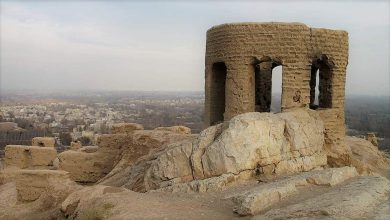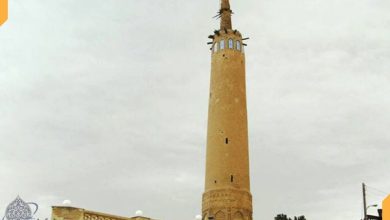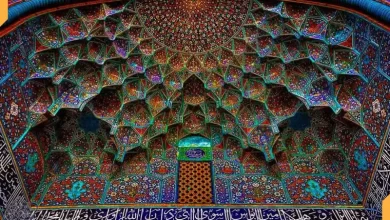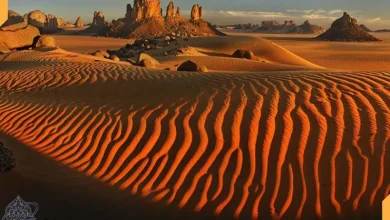Isfahan Beryani (Beryan or Beryuni)

In this article, we addressed to the introduction and the ingredients of this very delicious Isfahani food of also introduced some famous Beryani of Isfahan that if you traveled to Isfahan, certainly, test it and enjoy.
Isfahan Beryan (beryuni) is one of the most famous foods of Iran that its reputation was spread in other countries and also has lots of fans among the Iranian. this food belongs to Isfahan city and is considered as the most famous traditional food of Isfahan.
Perhaps you didn’t hear the name of local foods of Isfahan like meatball (Gheymeh Rize), but undoubtedly you heard the name of biryani that the proper name of it, is Beryan or beryoun.
it has a special position in the beautiful city of Isfahan. of course, the name of “beryan” is put on different foods in different parts of the world, but Isfahan beryan or beryani is prepared from the meat of sheep that is boiled and then grinded up. after that, this meat is pouring in the special skimmer along with cinnamon and mint and cooked on the fire.
this meat is usually served on the sangak bread with the baked and grinded lung. there are special restaurants in the Isfahan city that serve only biryan and its broth (Abe Gousht) and don’t have other foods.
that’s why these restaurants called “the beryani“ and when people from other cities see the name of Beryan in the stores, they often imagine that the name of the food in beryani. the Isfahan beryan is famous for it’s being lubricity.
The materials/ ingredients:
- six sheep
- onion
- the meet of wrist-band of a sheep
- oil
- decoration with walnut, basil and vegetables
- turmeric, salt and pepper
- bread

Isfahan Beryan:The history
That beryan is the most special food of Isfahan that the place of preparing and selling of it is separate and exclusive and usually it is not cooked with other foods, shows the importance of it between the people of Isfahan. of course, just the native people of Isfahan know that the name of this food is “beryan” and others wrongly call it beryani.
the word of beryani, is a relative adjective in the grammar of Persian and it is used for the place and the store of cooking and selling the biryan in the Isfahan. the suffix of “i” is attached in the place of noun, as for the adjective؛ so, the name of food is beryan, not beryani.
one grammatical- literary incident has also happened in this world and that is the science of “Belghalbe” or the metaphor of common and proper.
in the far parts of the world, it was said beryan to the different kinds of food and of course, they used it more as the composite, like beryan rice (Polo), beryan goose, beryan flying chicken؛ these compounds can be found in the old pamphlets of cooking.
right now, in many parts of the world, foods cooked as a “beryani“ that is totally different from what called beryan in Isfahan؛ like:
- Indian beryani, bermei beryani
- homemade Bangladeshi beryani
- Sri Lanka beryani
- Iraq beryani
- Sandi beryani.
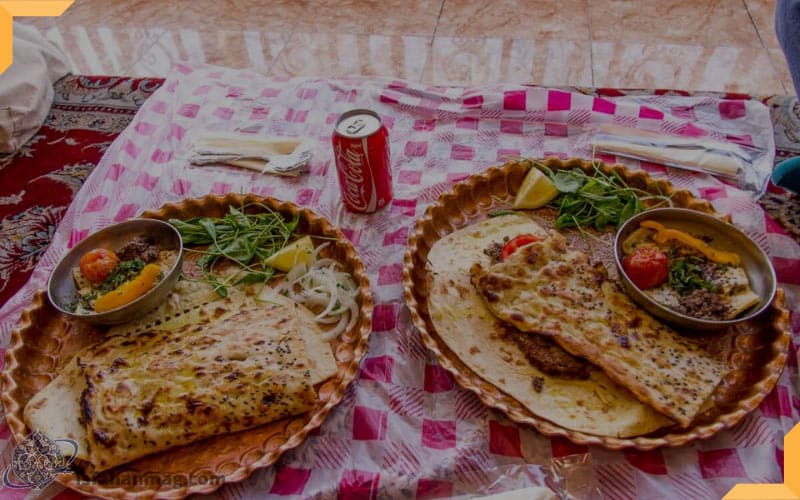
There is also many evidences of the word “beryani” in the ancient literature of Persian that it was used as an adjective for other foods or as a proper name of old food, in the sense of baked meat with rice and other trimmings.
What comes out of evidence of literal and historical context, is that Isfahan beryan doesn’t contain any of these titles and is a special food that cannot have more than 400 years’ antiquity, so not those who were written that the history of beryan reaches to the period of Zoroaster, have any accurate witness for proving it, nor those who don’t think that the antiquity of it is for more than 180 years prior the Qajar period, in fact, they don’t know anything about beryan in Safavid contexts.
The biryan that today the people of Isfahan and its visitors know it very well, is a food that it’s fatty, delicious and special for them to launch that is prepared from the pure meat of sheep.
today, first half-cooked the meat with its bones in the water alongside with onion, salt and a little spice like turmeric and then separate from bones and grind up with the fats of its own meat and then put in the oily bread with the broth (Abe Gousht) of that meat with the meat of walnut or almond slice bread, consume it with some lungs and grinded, baked fat that is the food’s decoration and known with the name of “lungs and fat” (Shosh va Donbeh).
It is a fat and heavy food, anyway؛ especially when some add the broth soaking (Telit) and curd (Kashk) beside it with dough, basil and onion.
all of these have many fonds in Isfahan, but when we know that the quality of cooking it was very different once upon a time and the phenomenon of frying that decreases the nutritional value of it, didn’t got used, we regret for this transformation that like many phenomenon’s of life in the form of today’s hurried and retrogressive is a caricature of its traditional figure.
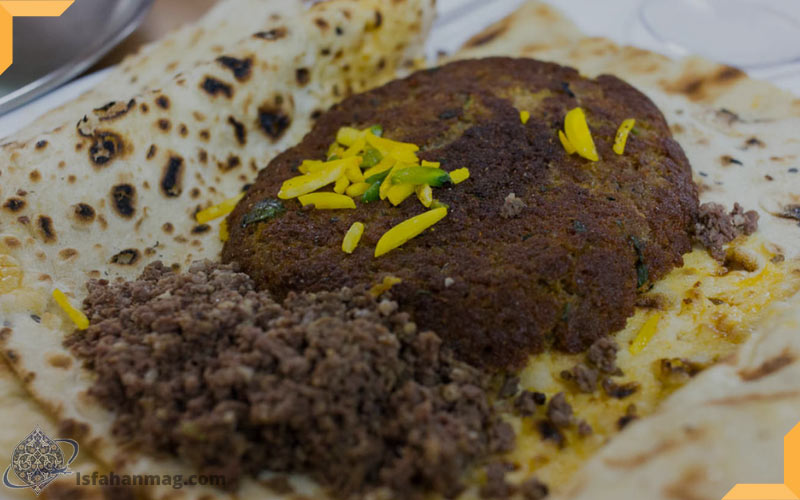
Beryan in the period of Safavid and Qajar
Many of the travelers that visited Isfahan in the period of Safavid, also provided a description of Isfahan beryan. “Tavernier” that had written his observations from Iran between the years of 1632 to 1668 A.D., writes in his itinerary that:
“Iranian roast the meat just in the oven (Tanur) and their oven is so different with our ovens. the Iranian oven is a hole that has 2 feet and half length and width and delve it with the depth of 5 to 6 feet in the earth and also warm it with a little firewood and the blade of a locoweed (tighe gavan).
it has another fuel that it is the dung of cattle that mixed with some dust, hit it to the wall to become dry. then store it on each other and use it when burning the oven or other fuel.
make the sheep ready and hung it in oven, not being chopped and put a pot full of rice in the floor of oven that it is cooked with the warmth of oven and the fat that is dropping from it.”
Hereabout, “Jean Chardin” explains about Isfahan beryan in two forms: the big pieces of meat that it is being roasted in the oven with a pan. there is a way of grilled pan that roast the whole sheep, lamb or goat with its own broth and it is so good. like Tavernier, he says:
“their oven is consisted of holes in the earth. the animal is being hung from the iron skewer that it is passed from its neck and is contrived to the opening of the oven and beneath it, some baked clay is being put. the animal here is cooked with the same heat. without burning, the pans that the kebab is being roasted, are the same as the pot specific for pastry.”
“Noor Allah”, the learned and famous chef of shah Abbas also writes about beryan in the epistle of “Madeh Alhayuh“:
“After killing the lamb, make it pickled with salt, from the beginning of the night to the morning and from the morning to the prior. after that, cook the rice in a simple way in the oven and also make it white and mixed with domestic oil and this would not need any peas or spices and the fire of oven… put it on the oven and sature the lamb, hung on the oven with the yogurt that was rubbed and get the head of the oven.
on the head of oven, they put fire to the extent of moderation and fill the stomach of lamb with dried plum, onion, green raisin and spices of Kofta (meatballs) and hung on the mentioned rule and call this kind, beryan and dalameh.”
It is so obvious that this kind of beryan, first eaten with rice. except the mentioned spices and the way of learned heat, the meat of this commodity has a basic role in the taste and flavor of it. Jean Chardin also says:
“In Iran from February to May, yeanling is found which in my opinion is the most delicious eatable meat, and from March to July, the meat of lamb that is also great and pleasant is achieves.”
in the period of Qajar, the inner ovens of the earth became to external ovens. the free room-like space, like the oven of sangaks. “mirza hossein tahvil dar” writes about that:
“There are several stores in the Isfahan that gives beryan (beryoun) to the whole city and it’s beryan is cooked completely in one factory and it is pleasant for Isfahan. they wanted to provide it in the Tehran, it didn’t get currency, what about other provinces that it cooked without deception.
markets won’t reach each other for business, etc., with the food better than this. most the houses have this on the day and part of their lunch. our limbo is between the kebab and broth of boiled meat.
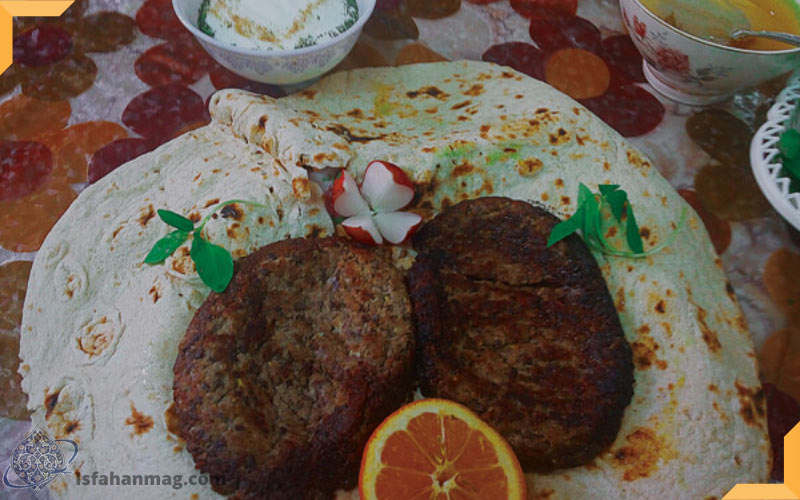
it is tastier and more eatable from both. they have vast big ovens. in the mentioned factory, the big and fat sheep are hung between the oven, after roasting in it and in the bottom of the oven, put a pot with half water. they put the lid of mentioned oven.
they put its lid from morning to night and when they picking it up, the meat became so baked from the vapor of water that some of the bones are separated, also the broth and fats and what came out, goes to the middle of the pot with boiling water, make it a good, dense broth and they sell its water.
they put its meat on the tray (Tabkh) and take it to the store of selling the beryan.”
From this description, it is found out that in the period of Qajar, the beryan was so popular that big chefs worked for cooking the sheep together and then the share of each store was sent in a specified manner. in these stores, it became large chopped with a knife.
the description of cashier in the manner of ancient beryan (beryuni), more accurately of all, reveals for us that the beryan was so delicious, tasty, beneficial and harmless commodity. they put the meat on the tray and sent it to the store of selling the beryan. making it large chopped with a big knife and sell it little by little.
at this time, they were cheated and boil it in the middle of the pot with low level of water and it is the false of the original beryan. again among the marketers, it is not tasty as the cooked one.
As what is seen from the epistle of geography of Isfahan and “mirza hossein tahvil dar” explains and describes this special phenomenon of Isfahan in the year of 1280 lunar, some were cheated and boil the meat like today, in a pot with low level of water in the same oven, but at the same time, “Pierre Loti” also acknowledges that the most important food of Isfahan in terms of Anubanini that it is so considering by passengers and visitors is called beryan or beryoun that is a meaty and so fatty food and in the most parts of city it can be prepared.
certainly, common admissibility and acceptability of beryan, indebted to the taste and its properties. in a way that not only they tried to cook it in the houses, but according to the tale of the history of Isfahan in the Qajar period, there were 68 shops of beryani were worked in Isfahan an. after water mill, grocery and crocheting, it was on the fourth grade.
Every year in the week of tribute of Isfahan in the month of Azar, the festival of cooking the beryan is being held in Isfahan.
Question and answer:
- Is the right pronunciation of this food is “beryan” or “beryani”?
The right pronunciation of this food is “beryan” and the restaurant that the cooking of beryan is done in it, called “beryani”.
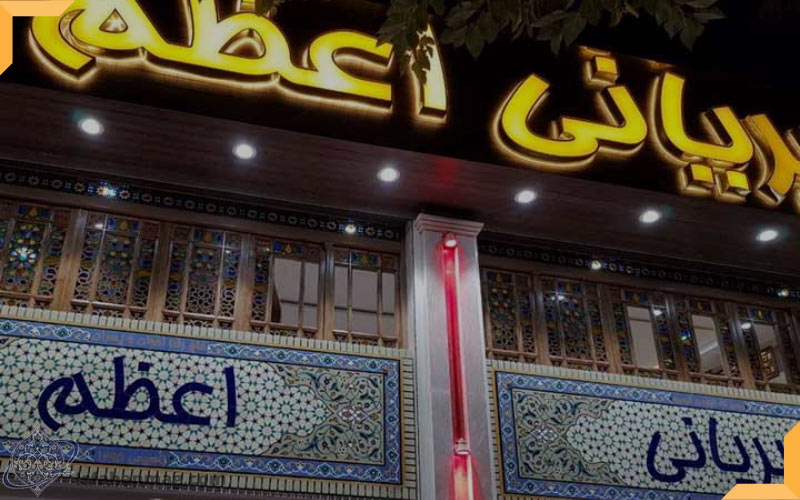
- What are the most famous Isfahan beryan?
- Azam beryani: government gate, beginning the of four garden of Abbasi, the main branch
- Shad beryani: government gate, beginning of the Taleghani street
- Reyhoun beryani: Mellat park, division of Azar bridge and Kowsar hotel, next to the city bank
- What are the ingredients of Isfahan beryan?
The meet of sheep’s neck, liver, onion, salt, pepper and turmeric, almond slice, walnut and cinnamon for decoration.
Conclusion:
Isfahan has many traditional foods and meals that one of the oldest and the most delicious of them is beryan that is so fatty, but it’s not a reason to not try it for once. beryan and its ingredients, history and introduction and also the opinion of famous people about this delicious food, is also stated.
 Write your opinion about the taste of Beryan and the place which you ate Beryan there.
Write your opinion about the taste of Beryan and the place which you ate Beryan there.

